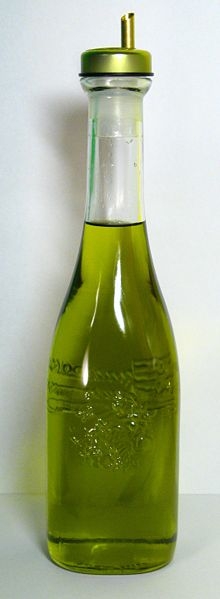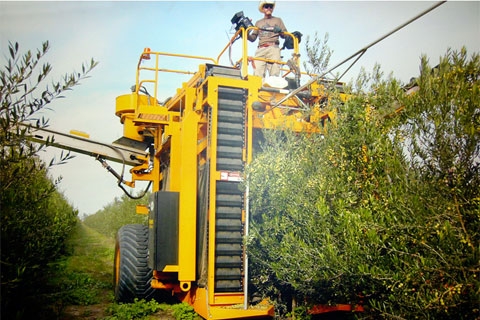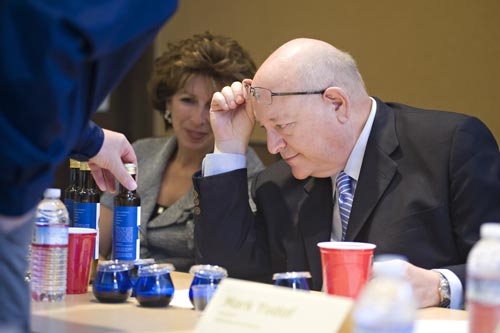Posts Tagged: Dan Flynn
Consumers like rancid olive oil
A study conducted by UC Davis sensory scientists Claudia Delgado and Jean-Xavier Guinard found that consumers prefer rancid olive oil to the bitter and pungent olive oil favored by experts, said an article in Olive Oil Times. The findings suggest a need for consumer education to keep California olive oil in position for growth.
For the study, 110 consumers rated 22 commercial olive oils. Key findings:
- 74 percent said they disliked the oils identified as high-quality by expert tasters
- Consumers preferred oils with fruity attributes identified as nutty, ripe fruit, green tea, butter, green fruit and grassy
- 44 percent of the consumers liked sensory defects like rancidity, fustiness, mustiness and winey flavor
The story offered a few possible explanations. A large amount of defective olive oil labeled as extra virgin is available to consumers, and the bitter and pungent flavors typical of high-quality oils are an acquired taste.
Director of the UC Davis Olive Center Dan Flynn told reporter Lori Zanteson that California consumers have much to learn about olive oil flavor profiles
"A bitter profile is not necessarily bad," Flynn was quoted. “All these discussions and the availability of quality oils are contributing to this slowly growing knowledge that the consumer has.”
The research report, “How do consumer hedonic ratings for extra virgin olive oil relate to the quality ratings by experts and descriptive analysis ratings?” appears in the March 2011 issue of Food Quality and Preference journal.
In their article, Delgado and Guinard predict the California olive industry will be poised for exponential growth "as consumers learn about the many nutritional benefits and sensory qualities of extra-virgin olive oil."

Good olive oil is an acquired taste.
California olive oil production could soon be among the world's Top 10
With olive trees planted in 2008 beginning to come into production, Cooperative Extension olive expert Paul Vossen predicts this year's California olive oil crush will be the highest ever, according to an article in The Olive Oil Times.
Producers are expected to squeeze 4.5 million liters of oil from olives harvested in California.
The rapid planting-to-milling rate is a result of super-high-density planting. Traditionally, about 100 olive trees were planted to the acre. With the new system, 500 trees are planted to the acre in hedgerows, which come into production more quickly and allow for efficient mechanical harvesting.
Reporter Lori Zanteson also spoke to Dan Flynn, director of the UC Davis Olive Center. He said people are consuming more olive oil each year. Increased production in California means there are larger supplies of high quality oil to meet the demand.
In fact, high-density planting has the state's olive oil production growing at such a rate that Flynn believes California could rank among the world’s top ten olive oil producers within the decade.

Olive oil production.
USDA's new olive oil standards take effect Monday
The USDA's new voluntary guidelines defining "extra virgin" olive oil go into effect Monday, but many of California's producers are already following even stricter regulations set down by the California Olive Oil Council, according to an article in the Ventura County Star.
USDA's guidelines allow for no defects and no more than 0.8 percent free oelic acid in olive oil labeled "extra virgin;" COOC requires no defects and no more than 0.5 percent free oleic acid.
The new guidelines come on the heels of a UC Davis Olive Center study finding that of 52 bottles of 19 brands of extra virgin olive oils sampled, 32 failed to make the extra virgin cut as described in the new guidelines. The study focused on imported brands, but included two samples each of five California brands. Of the 10 California samples, one failed the extra virgin test.
Even though they are voluntary and there is uncertainty over how or even whether they will be enforced, executive director of the UC Davis Olive Center Dan Flynn welcomes the new national guidelines.
“This is an important first step, because the current guidelines date back to 1948 and are irrelevant to the way olive oil is marketed today," Flynn was quoted in the story. "Instead of ‘virgin’ and ‘extra virgin,’ they use terms like ‘Grade A Fancy,’ as though you were talking about cans of fruit cocktail. It’s a consumer-protection issue."

Olive oil.
President's Blend: Yudof chooses olive oil
Signed, sealed and soon to be delivered: University of California President Mark Yudof’s own blend of olive oil.
UC Davis already has its own popular olive oil, sold in the campus bookstore and online, with customers including Yudof. The self-supporting UC Davis Olive Center – the only academic center of its kind in North America – is looking to branch out with the UC-wide President’s Blend.
A day before Yudof began his tour of high schools to promote access to a UC education, he visited the UC Davis Olive Center on Sept. 30 to give his official seal of approval to the President’s Blend olive oil.
Accompanied by UC Davis Chancellor Linda Katehi and leaders of the campus’ Robert Mondavi Institute for Wine and Food Science, Yudof chose from five blends made with olives grown in California. His favorite? A blend 25 percent Frantoio (Italian) olives and the rest Arbequina (Spanish) olives, the most commonly planted olive in California. Nutty? Yes. Pungent? Check. Bitter? No. Yudof also chose a label design with an image of olives, the UC seal in the middle and the words “President’s Blend.”
“I’m really humbled,” said Yudof, who plans to buy bottles of his blend to send to relatives.
The President’s Blend is expected to be available by the winter holidays. The plan is to sell it at all UC campus bookstores in quarter-liter bottles for $12 apiece.
“We’re hoping we can get out to the other campuses and expose them to really good olive oil,” said Dan Flynn, executive director of the UC Davis Olive Center.
In July, the Olive Center garnered international attention with its study that found many imported olive oils sold in California are not “extra virgin” as their premium labels claim they are. The center is doing a second study to confirm the results, UC Davis professor and sensory scientist Jean-Xavier Guinard said.
The center, part of the Robert Mondavi Institute, collaborates across campus and among producers and the community to promote olive and olive oil research and education. Before testing the olive oil blends, Yudof visited a mobile olive mill, enclosed in a custom-built 38-foot trailer. Olive to Bottle owner Thom Curry brought it for the center’s sold-out course for olive oil producers. “It’s basically like making fruit juice,” Curry said. “The fresher, the better with olive oil.”
Yudof, who also toured the Robert Mondavi Institute’s newly completed, environmentally cutting-edge winery, brewery and food-processing complex, noted the economic promise of California’s growing olive oil industry. California produces almost all olive oil made in the United States, although that amounts to just 1 percent of total domestic consumption in the import-dominated market.
“The olives have the potential to be one of the leading crops in the state, with UC Davis being a leader in the industry, just like with wine and almonds,” Yudof said.
Read more and view a slideshow at Dateline UC Davis.
Starting a rEVOOlution
A traditional crop is getting a modern makeover – and UC Davis is cultivating its growth in California.
The UC Davis Olive Center last month hosted a symposium on super-high-density olive production – a relatively new practice that has fueled the expansion of California’s olive oil industry. The production system, developed in Spain, reached the Golden State in 1999 and has taken off in the past five years. California accounts for almost all domestic olive oil production – now 850,000 gallons a year – and is poised to become a global player.
“California could within the next 10 years rank among the top 10 olive oil producers in the world,” said Dan Flynn, executive director of the UC Davis Olive Center.
Traditionally, olives have been planted at about 100 trees per acre and harvested by hand. Super-high-density olives are planted at more than 500 trees per acre and harvested by machine. The method lowers harvesting costs and speeds the turnaround from orchard to mill, a key to freshness and flavor. More than 100 growers attended the sold-out symposium to get the inside scoop – “a great deal of useful information,” Flynn said.
The self-funded UC Davis Olive Center, launched in 2008, is the only academic center of its kind in North America. Collaborating with industry, it published an olive production survey in November. The center made headlines with its just-published study that many premium-priced imported olive oil brands labeled as extra virgin – even those of EVOO queen Rachael Ray – aren’t as pure as they claim (California oils fared better). Upcoming projects could include research on super-high-density yields, costs and compatibility.
With olive oil consumption growing nationally, the climate is right in California, which has about 17,000 acres of super-high-density olives after 4,500 acres were planted in 2009. The most popular regions to grow olives for oil are Glenn and San Joaquin counties, putting Davis at the heart of the movement.
UC Davis has a history of helping to propel California agricultural products to worldwide prominence, such as grapes and wine. “It’s possible that something similar could happen with olives,” Flynn said.

Mechanical harvesting at Corto Olive (Photo by Corto Olive)

